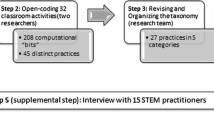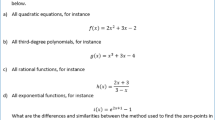Abstract
The issues surrounding teaching object-orientation to novice programmers from day one are revisited first. An analysis is then presented showing the harmfulness of teaching objects-first. The attention then is given to addressing the problems of the current textbooks. Furthermore, a remark is made in comparison between teaching objects-first and Reformed Calculus from a closed discipline. Finally, a new structure for introductory programming courses is suggested.
Similar content being viewed by others
References
ACM/IEEE-CS Task Force, (2001) ACM Computing Curricula 2001 for Computer Science. http://www. computer.org/education/cc2001/final/index.htm
Agarwal, R., et al. (2000) On the usability of OO representations. Communications of the ACM, 43(10), 83–89.
Barnes, D. and Kölling, M. (2003) Objects First with Java a Practical Introduction Using Blue J. Prentice-Hall, Englewood Cliffs, NJ.
Brooks, F. (1987) No silver bullet: Essence and accidents of software engineering. Computer, 20(4), 10–19.
Cooper, M., et al. (2003) Teaching object-first in introductory computer science. In Proceedings of the 34th SIGSCE Technical Symposium on Computer Science Education, pp. 191–195.
Decker, R. and Hirshfield, S. (1994) The top 10 reasons why object-oriented programming can't be taught in CS1. SIGSCE Bulletin, 26(1), 51–55.
Johnson, R. (2000) The ups and downs of object-oriented system development. Communications of the ACM, 43(10), 69–73.
Kölling, M. (1999) The problem of teaching object-oriented programming, Part I: Languages. Journal of Object-Oriented Programming, 11(8), 8–15.
Ledgard, H. (2001) The emperor with no clothes. Communications of the ACM, 44(10), 126–128.
Lewis, J. and Loftus, W. (2001) Java, Software Solutions, 2nd edition. Addison Wesley, Reading, MA.
Mazaitis, D. (1993) The object-oriented paradigm in the undergraduate curriculum: A survey of implementations and issues. SIGSCE Bulletin, 25(3), 58–64.
Meyer, B. (1989) From Structured Programming to Object-Oriented Design: The Road to Eiffel. Springer, Berlin.
Morelli, R. (2002) Object-Oriented Problem Solving Java, Java, Java, 2nd edition. Prentice-Hall, Englewood Cliffs, NJ.
Pont, M. (1998) Why Java is dangerous. IEEE Software, January/February.
Reek, M. (1995) A top-down approach to teach programming. SIGSCE Bulletin, 27(1), 6–9.
Schach, S. (2001) Object-Oriented and Classical Software Engineering, 5th edition. McGraw-Hill, Englewood Cliffs, NJ.
Stroustrup, B. (1994) The Design Evolution of C++. Addison-Wesley, Reading, MA.
Temte, M. (1991) Let's begin introducing the object-oriented paradigm. SIGSCE Bulletin, 23(1), 73–78. US Department of Education. http://www.ed.gov/offices/OVAE/HS/mst.html
Wang, W. (2002) Beware the engineering metaphor. Communications of the ACM, 45(5), 27–29.
Wick, M. (1995) On using C ++and object-orientation in CS1: The message is still more important than the medium. SIGSCE Bulletin, 27(1), 322–326.
Winslow, L. (1996) Programming pedagogy – a psychological overview. SIGSCE Bulletin, 28(3), 17–22.
Wu, T. (2001) An Introduction to Object-Oriented Programming with Java, 2nd edition. McGraw-Hill, Englewood Cliffs, NJ.
Zeng, N. and Schach, S. (2000) Is the object-oriented paradigm appropriate for scientific software? (Unknown publication status.)
Author information
Authors and Affiliations
Rights and permissions
About this article
Cite this article
Hu, C. Rethinking of Teaching Objects-First. Education and Information Technologies 9, 209–218 (2004). https://doi.org/10.1023/B:EAIT.0000042040.90232.88
Issue Date:
DOI: https://doi.org/10.1023/B:EAIT.0000042040.90232.88




